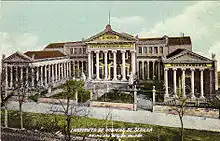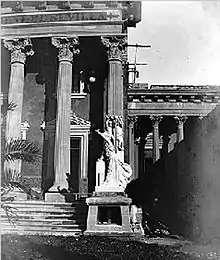Instituto de Higiene del Doctor Murga
The Instituto de Higiene del Doctor Murga (Institute of Hygiene of Doctor Murga) was a Neoclassical building on the calle Marqués de Paradas nº 35, Seville, and belonged to Leopoldo Murga Machado, founder of the Institute of Hygiene.



The architecture was inspired by Roman temples as displayed in the British Museum. It was built between 1905 and 1907 by the architect Francisco Franco Pineda as a residence, clinic, and laboratory for Murga.[1] It was popular among the Sevillan elite of the time, as baths were inexpensive at the price of one peseta.[2]
Description
The central nave was dedicated to laboratory work, bacteriology and patient consultations. In the pavilion on the left was an electrotherapy center, and on the right, a hydrotherapy section. Fourteen bathrooms were provided, two of them expensively outfitted.
The garden was flanked by stone sculptures representing allegories of hygiene and bathing. These were by Adolfo López Rodriguez, a Sevillian sculptor of the early 20th century.
Demolition
It was closed in 1938 (during the Spanish Civil War) and abandoned until its demolition in 1958. The clinic which currently occupies the site, a simple, functional building, was built by architect Fernando García Mercadal in the late 1960s-70s.
References
- Maquinadepiquetas. "Derribos De". Derribosdesevilla.blogspot.com. Retrieved 2016-03-13.
- David M Luna. "Palabras Al Vacio: Sevilla Perdida Iii: Instituto De Higiene Del Doctor Murga". Dmluna.blogspot.com. Retrieved 2016-03-13.
| Wikimedia Commons has media related to Instituto de Higiene del Doctor Murga. |